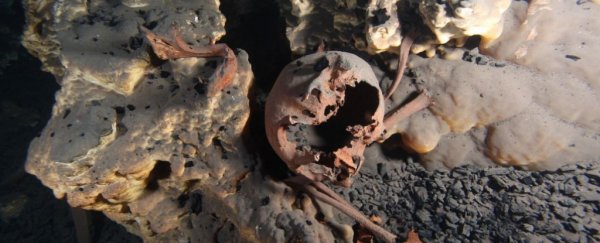Four ancient skulls discovered in a submerged Mexican cave system have archaeologists wondering if they were right about the earliest humans on the American continents.
It's thought that ancient populations settled these continents last, having crossed the Bering Strait from Siberia to Alaska during the last Ice Age, but the full story is far from set in stone. In their surprising diversity, these latest finds are a valuable data point.
A paucity of ancient remains from North America 15,000 to 20,000 years ago has meant that over the years, pretty much everything we thought we knew about these early humans and their subsequent migration to Central and South America has been called into question - from the timing, to the routes, to their biological origins.
Genomics data indicates that virtually all Native Americans descended from a single migration from Asia. But while populations in North and South America are often lumped together, they may have actually been quite distinct.
In this latest study, of the four skulls found in the limestone caves of Quintana Roo, none look alike.
Compared to modern humans, researchers were surprised to find the oldest skull looked similar to modern peoples in Greenland and Alaska, while the second oldest held stronger affinities with modern Europeans - something that hasn't been observed before in Paleoamericans.
Meanwhile, the third skull possessed more South American features, and the final resembled a jumbled fusion of modern Asians and Native Americans.
In light of these findings, the authors of the study suggest that early North Americans were unexpectedly diverse - far more so than South American populations at the time. What's more, it appears they were this way the entire time they occupied the continent.
With fewer than two dozen human remains discovered in early North America, there isn't a lot to compare these skulls to. Nevertheless, some other discoveries indicate that early North Americans may have been highly diverse, but as they trickled down into South America, like sand in an hourglass, populations gradually grew more uniform.
If this is true, then many models of migration and dispersal in this area of the world are seriously oversimplified.
"We always assumed that what was happening in South America was true in North America. Now we need to revise that," says anthropologist Mark Hubbe from Ohio State University.
"We need to stop talking about the settlement of the Americas. We should talk about the settlement of North America and the settlement of South America as very different."
The authors acknowledge that four skulls isn't a large sample size and may not accurately represent the populations of their time.
Given how little archaeologists have to work with, outliers of any sort are difficult to identify, but it would also be foolish to ignore the data we do possess.
The debate over the settlement of the Americas isn't going to end anytime soon, and these new skulls are only feeding the flames.
The study was published in PLOS One.
